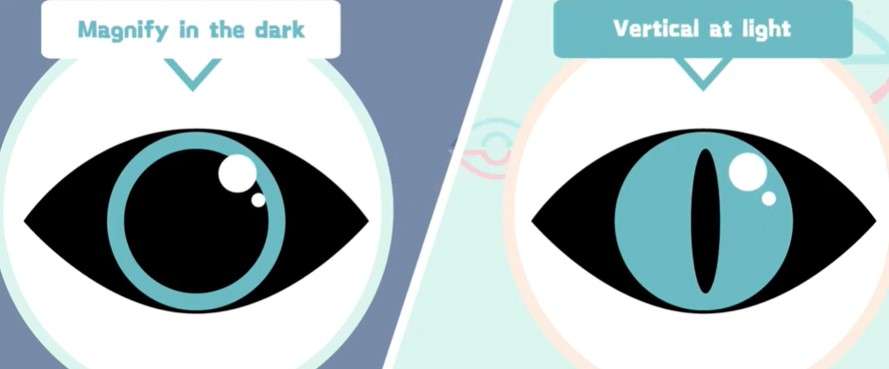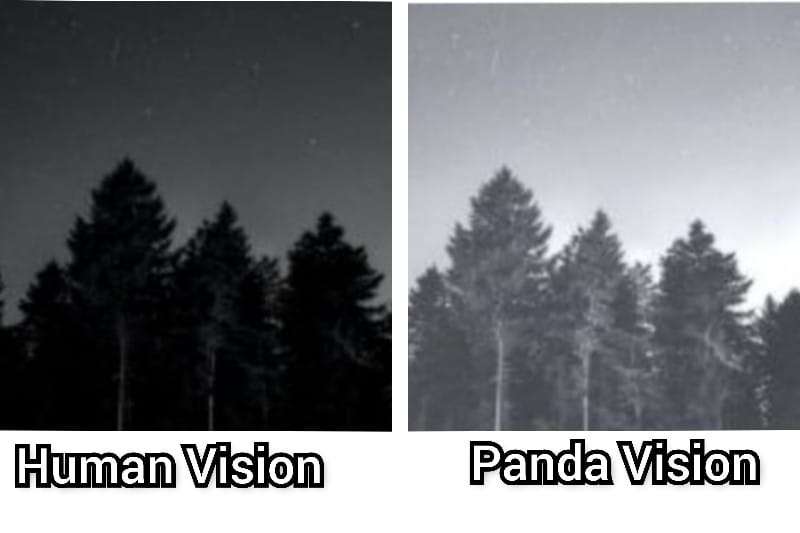Giant Pandas, also known as Panda Bears, are of the family Ursidae endemic to China. These black-and-white folivore bears are classified as a vulnerable species by IUCN.
Pandas are very cute, and many of you have seen them in various animations, shows, or documentaries. So, have you been fascinated by how Pandas see the world or how their vision is different from human vision? If yes, then below is the answer.
Pandas are dichromatic, and they see the world mostly in blue, yellow, and gray shades. They are born near-sighted, due to which they can only visually glimpse things clearly within a range of a few meters. After that, their vision becomes blurry, and they see faint objects.
Giant Pandas primarily spend too much time in the dense forests where there is always dim light. Therefore, their eyesight evolved into seeing much better in the dark, not in the daylight.
Their pupil acts the same as cats which give them the capability of controlling the intensity of light reaching their eyeballs. And through this, they become more adapted to perceiving the environment at night.
Here’s the summary. Later in this post, we have explained more about Panda Vision and how they see the world. So, without any further delay, let’s begin.
How do Pandas see the world?
Giant Pandas are born myopic and have the eyesight of negative eight diopters to the human eye. They can only see things clearly within a few meters, and a little further away, these things look blurry to them.
Also, they are dichromats, which means they have only two kinds of cones that are sensitive to blue and green wavelength hues. They are not colorblind and can differentiate blue, green, and gray shades.
In contrast, humans are trichromatic, and we have three kinds of cones that perceive blue, green, and red colors from 380 nm to 720 nm wavelength (visible spectrum). Compared to humans, pandas have poor day eyesight. However, at night, they gain supremacy over us.
Pandas are not totally dependent on their vision, but they are myopic. Hence to recognize the long-distance entities, they use their highly acute sense of smell and hearing. Like other bears, their hearing and smell are far much better than most animals.
Giant Pandas have their habitats in deep valleys and thick forests with dim light, and that’s the primary reason why over the years, their eyesight has evolved to relatively poor in daylight. Also, they are nocturnal bears. It means their eyes have more rods than cones.
Note: The retina has two types of photoreceptors to gather light, namely rods and cones. Rods help to control the brightness of light, whereas cones assist in distinguishing the millions of colors.
Pandas’ eyes are more concentrated on rods rather than cones. Also, their pupil plays a significant role in controlling the intensity of light, allowing them to perceive things in a low light condition. Below we have explained Pandas’ night vision in detail.
Can Pandas see in the Dark?
Pandas can see much better in the dark compared to humans. At night, their vision is similar to that of a cat’s. Giant Pandas don’t have tapetum lucidum in their eyes, but they are nocturnal and spend too much time in thick forests in low light conditions.
Hence, their eyes evolved in such a way to perceive much better at night rather than in daylight without tapetum lucidum.
Note: Tapetum Lucidum is a reflective membrane present in the eyes of the many nocturnal animals that reflects even the slightest light back to the retina, allowing them to see in the dark.

Credits: iPanda
First, pandas’ eyes are tended toward more rods than cones, which allows them to witness the environment even in the low light conditions (moon-light). Second, their pupils are in the form of vertical slits, just like cats. When light is too bright, their pupils shrink to reduce the amount of light entering the eyes.
On the other hand, at night, their pupils become dilated to allow even the slightest of light to enter their eyes. In this way, they can witness their surrounding at night.

In a nutshell, Giant Pandas have a night vision. Below are some frequently asked questions regarding Pandas’ night vision.
Are Giant Pandas Nocturnal?
Yes, Giant Pandas are nocturnal and can visually discern much better at night than us with their pupils’ help.
As explained above, Giant Pandas have tapetum lucidum in the back of their eyes, which helps them to see much better in low light conditions. In addition, they have more rods in their eyes that enhance the brightness at night time.
Can Red Pandas see in the Dark?
Red Pandas have excellent eyesight and can see easily in the dark. However, giant pandas and red pandas are not closely related. Red pandas are from a different family, i.e., Ailuridae.

As they are from different families but they both have a similarity to seeing better in the dark. Both Red Pandas and Giant Pandas evolve their eyesight to perceive the surrounding in the dark-dense forest.
Are Pandas Colorblind?
No, Pandas are not colorblind. They are dichromats and can see the world in blue, dull-yellow, and gray shades. They have two kinds of cones that allow them to perceive small and middle wavelength hues.
The research was done at the Georgia Institute of Technology, and Zoo Atlanta, which unveiled pandas are able to recognize colors and various shades of gray.
It was also noticed that pandas could distinguish green and blue in grays. However, still, it wasn’t conclusive till now what level of color vision they have.
Do Pandas have Good Eyesight?
Pandas have poor eyesight compared to humans. They are near-sighted and can see objects clearly within a few meters of range. Also, due to being dichromatic, they can only recognize small and medium wavelength colors.
However, Giant pandas have good night vision. They have vertically slit pupils that grant them the capability to adapt to the low light conditions and witness their surroundings in the dark. At night, they have the upper hand over us in terms of vision.
Panda Vision vs. Human Vision
| Panda Vision | Human Vision |
| Giant Pandas are dichromatic | Humans are trichromatic |
| They have better night vision and can see in the dark. | We cannot see in the dark |
| Pandas are near-sighted | We can see distant objects clearly. |
The fascinating world of panda vision has been unveiled through this article. Pandas, renowned for their distinctive black and white appearance, possess unique visual capabilities that aid their survival and daily activities.
Their large, round pupils enable them to adapt to both low-light conditions and bright sunlight. Furthermore, their color vision is limited, with a preference for shades of green and blue.
This visual acuity aligns with their bamboo diet and forested habitats. Pandas’ exceptional depth perception and spatial awareness assist them in climbing trees and navigating their environment.
Overall, understanding panda vision provides valuable insights into the remarkable adaptations of these beloved and endangered creatures.
Here, we conclude our article on “How do Pandas see the world,” along with ‘the comparison of Giant pandas’ vision to human vision. We hope you like it. We will be back with another post. Till then, stay tuned with us and read the articles below.
References-
- iPanda
- Giant Pandas See In Color by Science Daily
Also Read:

Meet Monty, the visionary founder of How It See, being an engineering student, he’s fueled by an insatiable curiosity about the world around him. He is captivated by an eclectic correlation between animal groups, science, and nature, and this fascination drives his quest for understanding.
After completing his degree, he’s set on a mission to delve deep into the realm of nature, accumulating knowledge to share with you through his writing. In the meantime, he loves to watch anime and read anime.

